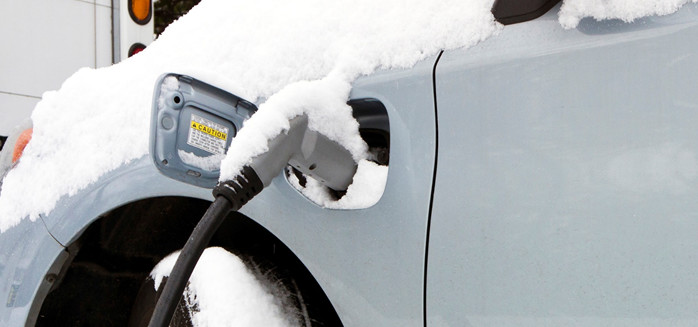
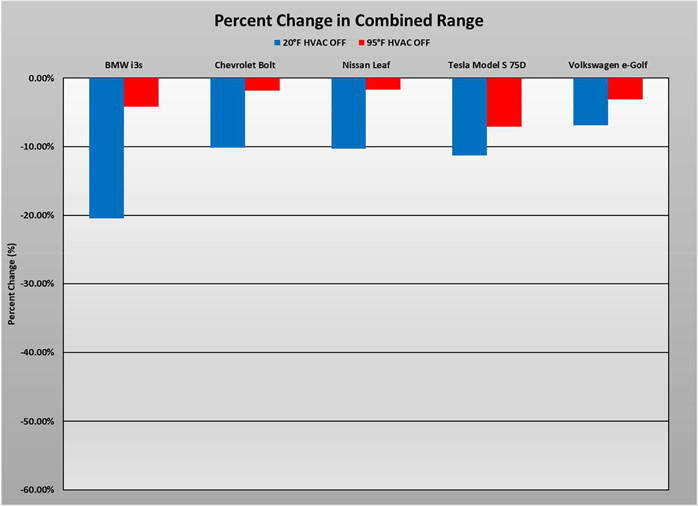 在温差75°F(约41.7°C)且关闭空调的情况下测试,续航里程百分比变化。(图片来源:AAA)
在温差75°F(约41.7°C)且关闭空调的情况下测试,续航里程百分比变化。(图片来源:AAA)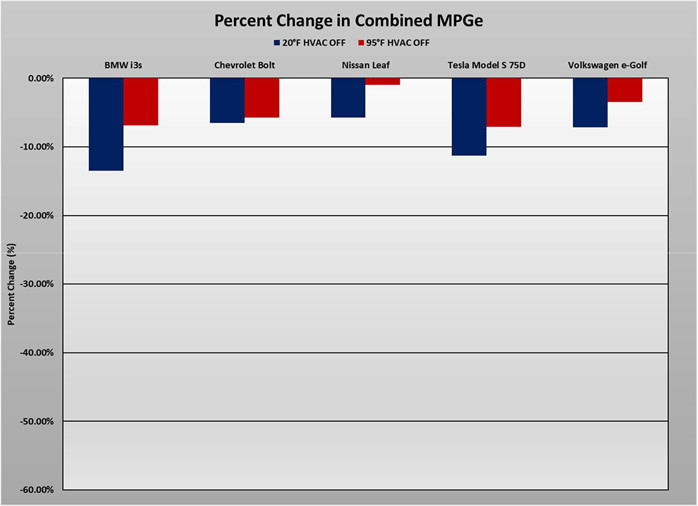 在温差75°F(约41.7°C)且关闭空调的情况下测试,,MPGe百分比变化。(图片来源:AAA)
在温差75°F(约41.7°C)且关闭空调的情况下测试,,MPGe百分比变化。(图片来源:AAA)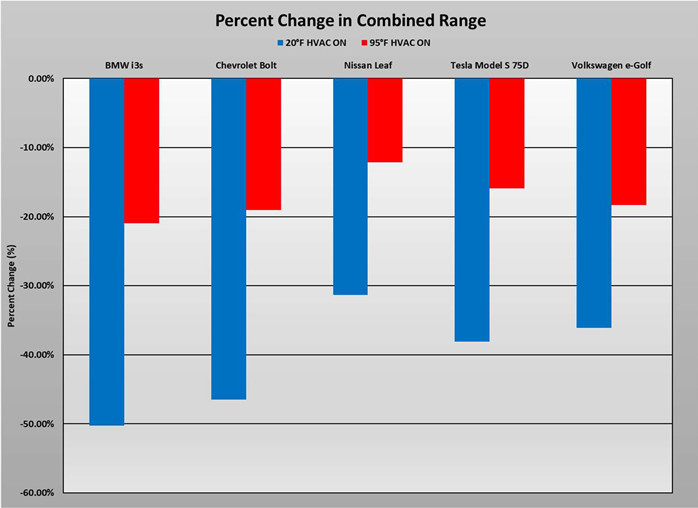 在温差75°F(约41.7°C)开启空调的情况下测试,续航里程百分比变化。(图片来源:AAA)
在温差75°F(约41.7°C)开启空调的情况下测试,续航里程百分比变化。(图片来源:AAA)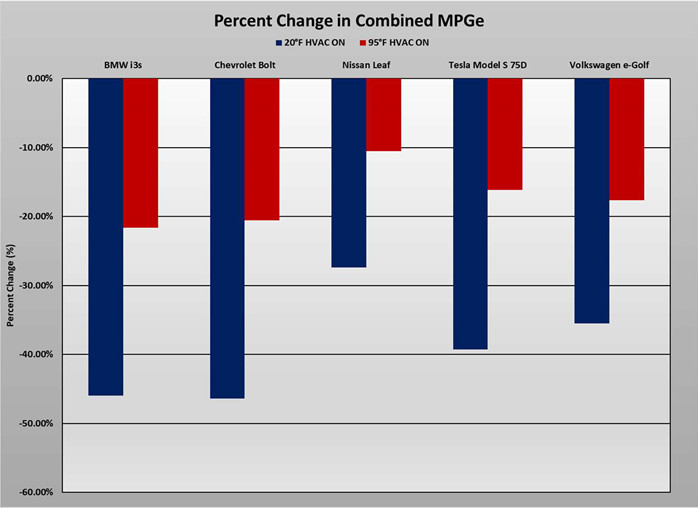 在温差75°F(约41.7°C)开启空调的情况下测试,MPGe百分比变化。(图片来源:AAA)
在温差75°F(约41.7°C)开启空调的情况下测试,MPGe百分比变化。(图片来源:AAA)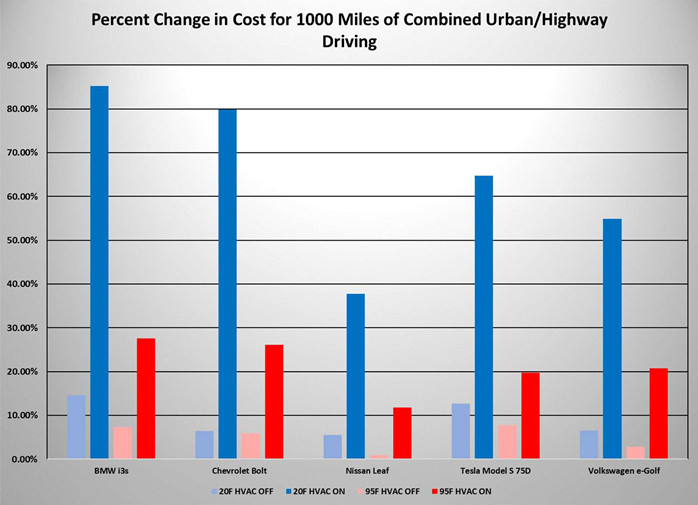 在温差75°F(约41.7°C)情况下测试,1,000英里(1,600公里)城市及高速公路综合工况下成本变化百分比。
在温差75°F(约41.7°C)情况下测试,1,000英里(1,600公里)城市及高速公路综合工况下成本变化百分比。
对于美国的大部分地区来说2019年的冬天是一个非常难熬的冬天。北极寒流极地涡旋夹带着骤强暴风雪横扫了美国中西部地区,甚至在通常气候温和的圣迭戈、洛杉矶以及拉斯维加斯气温也创下了历史新低。这对于越来越多的电动汽车拥有者来说绝对是一个坏消息,因为他们已经发现在极端温度下电动汽车的续航里程及充电时长都会受到不同程度的影响。
Henry Payne是一名底特律新闻的汽车评论家,他有一辆Tesla Model 3,Henry表示:“在寒冷的日子里,Model 3的续航里程至少减少了30%。”当然这不仅仅是他感受到了这种变化,Timothy Grewe 通用汽车电动推进实验室的首席工程师也感受到了,他有一辆全新的雪佛兰Bolt电动车,他说:“通常情况下,Bolt在充满电的情况下跑个270英里(432公里)是没有问题的,但是温度掉到负数时只能跑170英里(272公里)”
纯电动汽车在寒冷天气的续航里程问题,一直以来都是用户所关注的问题,也是在社交媒体上的常见话题。因此一些新的研究正试图量化这些影响。结果显示,当气温低于冰点时部分车辆的续航里程损失达到50%以上,但如果驾驶者关闭座舱加热系统的话情况会相对好一点。
AAA 美国汽车协会研究
最近的两项研究之一,同样也研究了高环境温度对续航里程的影响,我们发现热量也会影响续航但不会达到在寒冷天气时的那种程度。但即便如此,续航里程的降低不仅对车主造成了严重的影响,同样对于那些在未来的数年里准备向市场推出数十款电动化新车型的汽车制造商来说问题也一样严重。他们已经在这上面投资了数百亿美元,任何可能让消费者降低对电池技术吸引力的事情,都可能使得收回这些投资变得更加困难。
“我们发现温度对于电动汽车的影响远远超出我们的预期,”AAA汽车工程总监Greg Brannon说,“对于所有计划部署推出电动汽车的制造商来说,这是他们必须要处理的事情。”AAA总共测试了BMW i3,雪佛兰Bolt EV,日产Leaf,特斯拉 Model S和大众电动高尔夫这五款来自不同品牌的电动车型。AAA的工程师对每辆车分别进行了20°F(约零下6.7°C)以及95°F(35°C)的环境下的测试。
Brannon表示,事实证明这些车辆对热条件的反应非常相似,当室外温度在20°F(约零下6.7°C)且未开启座舱加热系统的情况下续航里程平均减少12%,这个下降幅度还是在可接受范围之内。但是一旦启动空调系统,续航里程则会平均下降41%,换句话说EPA核定范围为200英里(380公里)续航里程的纯电动汽车在这种情景下只能行驶118英里(188.8公里)。
这些数字还不能完全反映潜在的续航里程损失,这里还没有考虑在冬季通勤时还会打开座椅或者方向盘加热或是打开前照灯的情况,驾驶者可以切实体会到这些影响,此外不仅仅是续航里程减少他们会还支出更多的费用。根据AAA估计,一位典型的美国纯电动汽车车主每1,000英里(1,600公里)可能需要多支出24.27美元(约合165元人民币)。该研究团队同样还进行了在极热天气下的实验测试,当气温达到95°F(35°C),如果驾驶员愿意忍受酷暑,那么续航里程仅下降4%,但是一旦开启空调将直线下降17%。
(以电耗为例,美国EPA组织一直以能耗作为一辆汽车的重要指标,并设定了“MPG”值作为考量标准,而在新能源汽车“MPGe”的计算上,“e”代表的是每加仑汽油能行驶的英里数。将“汽油”转换为了“电”,换算后就变成每“33.7度”电可以行驶多少英里。)
消费者联盟研究
消费者报告杂志的出版商消费者联盟(Consumers Union)也进行类似的测试,其报告对AAA的调查作出了相同的回应。消费者联盟挑选了2款电动车进行了测试,一辆是特斯拉Model 3 EPA核定续航里程310英里(496公里),另一辆是日产的Leaf EPA核定续航里程151英里(241.6公里)。本次测试时室外平均气温在0-10°F(约零下17.8 ~零下12°C)的情况下进行。
当特斯拉实际行驶了64英里(102.4公里)后,续航里程表显示减少了121英里(204.8公里),剩余电量大概还可以行驶189英里(302公里)。而日产的表现更差,实际行驶了64英里(102.4公里)后,续航里程表显示“烧了”141英里(225.6公里),当测试结束时其续航里程表上显示仅剩10英里(16公里)。
电池适宜温度
AAA的Brannon表示,部分问题在于“锂离子电池和我们喜欢同样的温度,大约是70°F(21°C)左右。”如果外部温度远低于此,那么用于储存能量的化学物质会遇到各种问题。通用汽车的Grewe解释说,除此之外,电池组件还会产生越来越大的阻力,从而限制了它们可以承受的功率,以及电池组的充放电速度。
我们针对现代汽车 Kona做了一次明显不科学的测试,在底特律室外温度20°F(零下6.7°C)的一天,我们使用SAE L3级50-kW充电器对它进行充电测试,45分钟后里程表显示仅从31英里(49.6公里)充到了110英里(176公里),这几乎是汽车制造商在理想条件下承诺的一半。
在AAA进行研究测试的5个品牌中仅有特斯拉对结果表示异议,其发言人表示:“根据我们车队获得的实际数据显示,Model S在室外温度20°F(零下6.7°C)的情况下没有消费者反应续航里程发生减少的情况发生,而在95°F(35°C)的情况下也仅减少1%。”但是来自日产Leaf项目的高管Carl Phillips表示:“毫无疑问温度会对电动汽车的续航里程有所影响,且所有的电动车在寒冷天气中表现都很相似。”
行业专家表示,电动车主可以通过很多种方式避免续航里程的减少。大多数纯电动车辆在插入充电器时可以“预先调节”,比如驾驶员可以利用电网电能,在出门用车前使用智能手机应用程序或是信息娱乐系统的内置软件启动座舱加热系统给车辆升温。同时汽车制造商还鼓励驾驶员在冬季里,可以使用座椅和方向盘加热系统减少对空调系统的依赖。
AAA方法论
AAA与洛杉矶南加州汽车研究中心(ARC)的汽车俱乐部合作,针对在使用和不使用HVAC系统的情况下,环境温度对电动车行驶里程的影响进行了初步研究。本次测试使用到了以下设备:安培小时计,OBD-II扫描工具和测力计。
在选择本次测试车辆时预先设立了一套标准,比如该车型需要在全美国都有销售,EPA核定续航里程不少于100英里(160公里)。为防止单一品牌的过度代表,每家制造商仅可有一辆车参与测试。
It’s been a tough winter in much of the U.S. When the Midwest hasn’t been dealing with a Polar Vortex it been smacked by a “bombogenesis.” But even normally temperate seasonal regions like San Diego, Los Angeles and Las Vegas have been hit with harsh and, in some cases, record cold this year. That’s particular bad news for the growing number of owners of battery-electric vehicles who have discovered the impact extreme temperatures can have on both range and charging times.
“I’m consistently seeing a 30% degradation” in range on cold days, said Henry Payne, an automotive reviewer for The Detroit News and owner of a Tesla Model 3. He’s by no means alone. “I can get 270 miles [range] no problem,” from his Chevrolet Bolt EV with a fresh and fully charged battery, said Timothy Grewe, chief engineer at General Motors’ electric propulsion lab. But Grewe notes that when temperatures fell into negative territory, “I got around 170.”
The issue of cold-weather range has been a subject of concern among BEV owners for some time, and a frequent topic on social media. But several new studies have attempted to quantify the effects. The results are significant, showing that some vehicles lose more than 50% of their range in sub-freezing temperatures, though drivers can mitigate the losses if they’re willing to limit their use of cabin heating.
AAA study
One of the two recent studies also looked at the impact of high ambient temperatures and found that heat, too, can draw down range, though not to nearly the extend that cold does. Even then, degradation of range poses potentially serious problems not only for EV owners but for the automakers who are rushing dozens of new electrified offerings to market over the next few years. They’re investing tens of billions of dollars and anything that could reduce the appeal of battery-based technology could make it more difficult to recover those investments.
“We found that the impact of temperature on EVs is significantly more than we expected,” said Greg Brannon, AAA’s director of automotive engineering. “It’s something all automakers are going to have to deal with as they push for further EV deployment because it’s something that could surprise consumers.” The organization tested five separate models: the BMW i3, the Chevrolet Bolt EV, the Nissan Leaf, the Tesla Model S and the Volkswagen e-Golf. AAA engineers subjecting each car to both 20-degree F cold and 95-degree F heat.
The vehicles proved surprisingly similar in their response to the thermal conditions, said Brannon. He noted that, on average, they lost about 12% of their range on the cold side. That was a relatively modest decline, but it did not include the use of any form of cabin heating. When HVAC systems were activated, the range degradation averaged 41%. In other words, a BEV with an EPA-rated range of 200 miles would get only 118 miles between charges.
And those numbers don’t fully reflect potential range loss, as they don’t factor in the use of seat or steering wheel heaters or headlights during winter commutes. The impact is felt by motorists in various ways. Not only can they travel less per charge, but they also pay more. AAA estimated a typical American BEV owner would pay an extra $24.27 per 1,000 miles. The group’s study also examined what happens on extremely hot days. At 96 degrees F, range dipped 4%--if the driver was willing to sweat it out. With the HVAC turned on, range degradation climbed to 17%.
Consumers Union study
The AAA findings were largely echoed by a separate study conducted by Consumers Union, the publisher of Consumer Reports magazine. It focused on two EVs—the Tesla Model 3 with a 310-mile EPA rating, and the 151-mile version of the Nissan Leaf. Testing was conducted at the CU track on days when the outside temperature averaged between 0 to 10 degrees F.
The Tesla used up the equivalent of 121 miles to cover 64 actual miles of driving, leaving it with a displayed range remaining of 189 miles. The Nissan fared even worse, “burning” 141 miles of stated range to travel those 64 miles. At the end of the test, the second-generation Leaf had only 10 miles showing on its range display.
Electric habitable zone
Part of the problem, said the AAA’s Brannon, is that “lithium-ion batteries like the same sort of temperatures that we do, around 70 degrees.” Much below that and the chemistry used to store energy runs into various problems. Among other things, battery components develop increased resistance that limits how much power they can hold, as well as how fast a battery pack can be charged or discharged, explained GM’s Grewe.
A decidedly unscientific test of a Hyundai Kona on a 20-degree F day in Detroit found it was only able to go from 31 to 110 displayed miles after being plugged in for 45-minutes to a 50-kW SAE Level 3 charger. That’s barely half what the automaker normally promises under ideal conditions.
Of the five brands included in the AAA range study, only Tesla raised any real concerns with the results. “Based on real-world data from our fleet,” said a spokesperson, “the average Model S customer doesn’t experience anywhere near that decrease in range at 20 degrees Fahrenheit, and the decrease in range at 95 degrees Fahrenheit is roughly 1%.” That said, Carl Phillips, a Nissan executive working on the Leaf program, said there is no question, “temperature has an impact” on range, adding that “all EVs perform similarly in cold weather.”
There are some ways that an owner can reduce range degradation, according to industry experts. Most battery-electric vehicles can be “pre-conditioned” when they are plugged into a charger. That means a motorist can use a smartphone app or software built into the infotainment system to start warming the vehicle’s cabin up before they leave home, office or store, using grid energy. Automakers also encourage drivers to reduce their winter reliance on the HVAC system and stay warm using seat and steering wheel.
Percent change in cost for 1000 miles of combined urban/highway driving relative to 75°F
AAA methodology
AAA conducted primary research in partnership with the Automotive Club of Southern California’s Automotive Research Center (ARC) in Los Angeles to understand impacts of ambient temperature on electric vehicle driving range with and without the use of the HVAC system. Testing was conducted using the following equipment: ampere-hour meter, OBD-II scan tool and dynamometer.
Test vehicles were selected using a pre-determined set of criteria such as availability for sale throughout the United States with a minimum EPA estimated driving range of 100 miles. One vehicle per manufacturer was tested to prevent overrepresentation of a single brand. Additional information on methodology can be found in the full report.
Author: PAUL A. EISENSTEIN
Source: SAE Automotive Engineering Magazine
等级
打分
- 2分
- 4分
- 6分
- 8分
- 10分
平均分
- 作者:PAUL A. EISENSTEIN
- 行业:汽车
- 主题:燃料和能源管理与产品开发质量、可靠性与耐久性车辆与性能测试与检验
